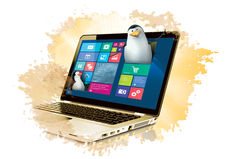Windows 8.1 in VMware and VirtualBox
Virtual Duel

For occasional Windows users, a virtual machine is the ideal solution. But will Windows 8.1 work in VirtualBox and VMware?
Life without Windows just doesn't work for many users. Some tools simply don't have a Linux equivalent, and other situations require Windows for compatibility with co-workers or clients. One easy solution is to run Windows applications directly on Linux using the Wine API. However, Wine doesn't support all versions of all programs. Another alternative is to dual boot, but a dual-boot configuration requires you to restart your computer whenever you want to switch systems.
The most popular alternative on today's networks is to run Windows in a virtual machine on a Linux host. VM technology is so mature that, in normal use, it is difficult to tell the difference between Windows on a virtual machine and on a physical system. (One exception is gaming, which tends to work better without virtualization.)
The biggest players in the market for Windows desktop virtualization on Linux are VirtualBox [1] and VMware Workstation [2]. I took a look at how these leading virtualization alternatives work with the latest Windows.
[...]
Buy this article as PDF
(incl. VAT)
